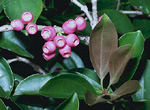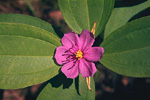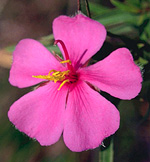 |
This large, pantropical family is particularly well represented in tropical South America. In Australia the family is restricted to the tropical north and east, extending south to northern New South Wales. Most grow in seasonally damp places, often on sandy soils.
Characteristic features of the family Melastomataceae in Australia include: - shrubs or small, soft-wooded trees, rarely lianes or herbs
- leaves opposite and decussate, borne on usually square stems with bristly hairs
- leaves usually distinctively broad-elliptic and with prominent veins that are parallel and convergent at the base and apex
- flowers with a hypanthium surrounding or fused with the ovary, and large, colourful (often dark violet or purpele but also white, pink, yellow or red) unfused petals
- anthers distinctive, usually curved or elbow-shaped and bearing various basal appendages
Description
Evergreen trees, or shrubs, or woody or herbaceous scrambling vines, or perennial terrestrial herbs. Stem nodes conspicuously swollen or not; internodes ± terete, or distinctly angled, or winged. Internal secretions not obvious. Plants glabrous, or with simple, non-glandular hairs. Leaves opposite or in whorls of 3 or 4, or rarely alternate or spiral, petiolate, subsessile or sessile. Stipules absent. Lamina simple, symmetric, linear, filiform, acicular, subulate, ovate, lanceolate, elliptic, obovate or orbicular; base cuneate or rarely attenuate; margins entire, ± flat; venation not obvious, 1-veined, pinnate, or palmate, or parallel, with the midrib conspicuous or inconspicuous, and the tertiary venation reticulate; surfaces not punctate; herbaceous or leathery; distinctive odour absent or ?aromatic. Domatia present. All the flowers bisexual. Inflorescences terminal or axillary, consisting of panicles, dichasial cymes, umbels, heads, small clusters or solitary flowers. Bracts and bracteoles present or rarely apparently absent. Pollination by insects or ?birds. Flowers odourless, sessile or pedicellate. Floral disc absent; nectaries absent. Free hypanthium present. Perianth of 2 dissimilar whorls or of 1 whorl only. Epicalyx absent or apparently present. Calyx regular; segments all free or apparently fused into a distinct tube, with 4 or 5 sepals or lobes, valvate or open in bud; calyx cup-shaped, bell-shaped or urn-shaped, herbaceous, leathery or membranous. Corolla ±regular; segments free, with 4-5 petals, alternating with the sepals or calyx lobes, convolute, ?crumpled or plicate, white, red, pink, purple, magenta, violet or blue, membranous; claws absent or ?present; lobes ± entire, or notched, emarginate, bifid or bilobed. Fertile stamens 8 or 10, both alternating with and opposite to the sepals or calyx lobes, free from each other and from all other flower parts, ±equal or of irregular lengths. Staminodes absent or present. Anthers dorsifixed or basifixed, not versatile or ?versatile, opening terminally or sideways by pores or longitudinal slits, 2-celled; appendages apical, dorsal or basal or rarely absent. Ovary half inferior or inferior. Carpels 4–5, fused; ovary with 4–5 or 1 locules. Style terminal, single, unbranched. Ovules usually more than 10 (rarely less) per locule, stalked or sessile; placentation axile or rarely basal, parietal or free central. Fruit dry or fleshy, dehiscent or indehiscent; a loculicidal or irregular capsule or berry; perianth on maturing fruit deciduous or marcescent. Disseminule macro-surface ± featureless; micro-surface tuberculate, colliculate, papillate, reticulate, alveolate or foveate, yellow, red, pink, magenta, purple, violet, blue or black, glossy. Seeds 1 or more than 10 per fruit. Aril absent. Cotyledons 2. Embryo straight or curved. (Note: this description has been generated from the coded data compiled for the key. Any errors in the key data will be reflected in the descriptions.)
A treatment of the family Melastomataceae has been published in:
Flora of Australia 18: 243-255.
Australian genera of Melastomataceae (as recognised for the Flora of Australia)
Medinilla
Melastoma
Memecylon
Osbeckia
Otanthera
Pternandra
Tristemma

|
  |

Medinilla balls-hedleyii (fruits)
Photo: H.Nicholson © H. & N. Nicholson

Melastoma affine (flower)
Photo: A.S.George © A.S.George

Melastoma affine (flowers and fruit)
Photo: H.Nicholson © H. & N. Nicholson

Osbeckia australiana (flower)
Photo: D.Jones © D.Jones

|
 |
|